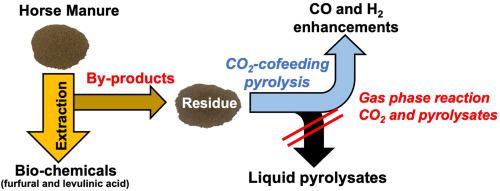Journal of Cleaner Production ( IF 11.1 ) Pub Date : 2021-09-20 , DOI: 10.1016/j.jclepro.2021.129109 Seong-Heon Cho, Sungyup Jung, Yiu Fai Tsang, Kun-Yi Andrew Lin, Young Jae Jeon, Eilhann E. Kwon

|
Animal manure contains a variety of organic materials that can be used for synthesis of value-added biofuels and chemicals. To maximize the carbon recovery from animal manure waste, this study focused on consecutive valorization of horse manure into furfural and syngas (H2 and CO). Acid hydrolysis/dehydration of horse manure was employed to extract furfural, and the residue after furfural extraction was valorized into syngas and bio-oil through CO2-assisted pyrolysis. In acid treatment process, the levulinic acid and furfural were produced from horse manure, and the maximum yield (3.68 wt%) of furfural was achieved at 0.5 M H2SO4 (40 wt% based on hemicellulose content). Horse manure residue was further converted into bio-oil and syngas under N2/CO2 environments. Under CO2 atmosphere, gas phase homogeneous reactions were occurred, which simultaneously reduced CO2 and oxidized bio-oil showing enhanced CO formation (18 times higher comparing to pyrolysis under N2). The homogeneous reaction also resulted in decrease of aromaticity in bio-oil. To enhance the reaction kinetics of the homogeneous reaction and thermal cracking of bio-oil under CO2, catalytic pyrolysis was performed in the presence of Ni/SiO2 catalysts. The catalytic pyrolysis improved syngas (H2 and CO) production more than one order of magnitude higher, comparing to pyrolysis without Ni catalyst. All the experimental findings suggested that horse manure and CO2 could be used as raw materials for production of value-added chemicals and syngas.
中文翻译:

将粪便转化为化学品和燃料的战略途径
动物粪便含有多种有机材料,可用于合成高附加值的生物燃料和化学品。为了最大限度地从动物粪便废物中回收碳,本研究侧重于将马粪连续增值为糠醛和合成气(H 2和 CO)。采用马粪酸水解/脱水法提取糠醛,糠醛提取后的残渣通过CO 2辅助热解转化为合成气和生物油。在酸处理过程中,以马粪为原料生产乙酰丙酸和糠醛,0.5 MH 2 SO 4 时糠醛产率最高(3.68 wt%)(基于半纤维素含量为 40 重量%)。马粪残渣在N 2 /CO 2环境下进一步转化为生物油和合成气。在 CO 2气氛下,发生气相均相反应,同时还原 CO 2和氧化的生物油,显示出增强的 CO 形成(比 N 2下的热解高 18 倍)。均相反应也导致生物油的芳香性降低。为了提高CO 2下生物油均相反应和热裂解的反应动力学,在Ni/SiO 2催化剂存在下进行催化热解。催化热解改进了合成气(H 2和 CO) 的产量比没有 Ni 催化剂的热解高一个数量级以上。所有的实验结果表明,马粪和CO 2可以作为生产高附加值化学品和合成气的原料。



























 京公网安备 11010802027423号
京公网安备 11010802027423号